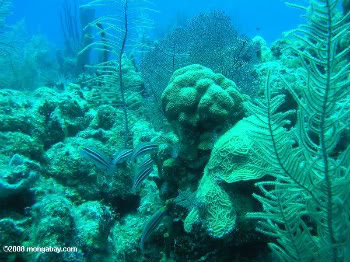|
|
Coral reefs in Belize, considered to be some of the most pristine in the west, have secured additional protections. Rene Montero, the Minister of Agriculture and Fisheries, signed a set of new laws this month to protect Belize’s coral reefs and the fish that inhabit them. The additional laws protect increasingly overfished species, ban spearfishing in marine reserves, and create no-take zones, according to a press release from the Wildlife Conservation Society (WCS).
“We applaud the Government of Belize for these progressive new laws that will ensure a future for coral reefs in the region,” said Dr. Steven E. Sanderson, President and CEO of WCS. “Belize has set a new standard for coral reef and fisheries protection in the Caribbean.”
 Coral reefs in Belize. Photo by: Rhett A. Butler. |
Algae-eating fish have gained special protection under the new law, such as parrotfish, doctor fish, and surgeon fish. Each of these herbivores has been shown to keep algae growth in-check, allowing for new corals to grow which otherwise would have been stymied by algae. Belize fishermen used to ignore parrotfish and other grazers, instead focusing on snappers and groupers. However subsequent declines in snappers and groupers due to overfishing led caused Belize fishermen to seek the next-best-fish namely parrotfish, a change that has threatened reef growth.
The new laws also protect the Nassau grouper, which is currently listed as endangered by the IUCN Red List due to overfishing throughout the Caribbean. While the Nassau grouper can still be fished in Belize, the new laws set a maximum and minimum for size and require that Nassau groupers be brought in whole, so that the declining fish can be better monitored. Another measure intended to help Nassau grouper is the ban on spearfishing in marine reserves. Spearfishing is a common method for catching groupers.
Finally, two marine reserves have been declared no-take zones, i.e. areas closed entirely to fishing. South Water Caye and Sapodilla Cayes marine reserves were created in 1996, but Belize has allowed fishing throughout the reserves until now.
Related articles
Coral reefs and mangroves worth $395-559 M per year in Belize
(11/14/2008) Services provided by coral reefs and mangroves in Belize are worth US$395 million to US$559 million per year, or 30 to 45 percent of the Central American country's GDP — according to a new report released by the World Resources Institute and the World Wildlife Fund (WWF).
The long-ignored ocean emergency and what can be done to address it
(08/18/2008) This year has been full of bad news regarding marine ecosystems: one-third of coral species threatened with extinction, dead-zones spread to 415 sites, half of U.S. reefs in fair or bad condition, increase in ocean acidification, tuna and shark populations collapsing, and only four percent of ocean considered pristine. Jeremy Jackson, director of the Scripps Center for Marine Biodiversity and Conservation at the University of California, San Diego, synthesizes such reports and others into a new paper, published in the journal Proceedings of the Naional Academy of Sciences, that boldly lays out the scope of the oceanic emergency and what urgently needs to be done.
(07/10/2008) Nearly one-third of reef-building corals are vulnerable to extinction, according to an assessment of 845 species of coral. Rising temperatures, increased incidence of disease, and human disturbance are driving the trend.